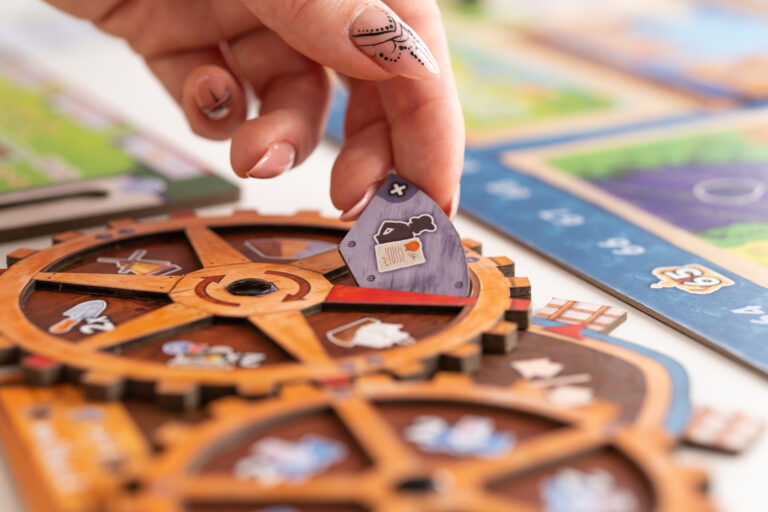
A common question whenever a designer is interviewed is, ‘Where do your game ideas come from?’. And the answer is always something similar to ‘they can come from anywhere when you least expect them’. Which is true, whatever you are doing, there’s always a chance an idea will pop up, a new theme, or a new mechanic for a game.
I usually have a hard time remembering what I was doing when I came up with the idea for a specific game, but I remember this one very clearly. It was while I was walking, following my usual looping route around a park, while pushing a stroller, trying to get my child, then less than a year old, to sleep for at least 40 minutes. It was in that state of sleep deprivation (for both of us), surrounded by trees, flowers, and the occasional fountain, when I thought it would be great to have a game using 2 connected cogs as an action selection mechanism. It would probably be about some kind of factory. If you were expecting me to say I was thinking about colorful tulip fields, I’m afraid that’s not where my mind was at that moment.
I kept refining the idea in my head during those walks, expanding it. It would not be a factory, it would be something else. I thought about a big cog in the middle of the main board, with many smaller cogs connected and expanding from it. I thought about steam and computers, and a grid of lightbulbs on your player board. Still, no windmills or tulips on my mind, as I was designing a game about being an AI inside a steampunk computer. I even had a name for it, which was either the best or the worst possible name for a board game: ‘Steam Perfected Mechanical Intelligence Apparatus of Countess Dorothy Harley-Willowby’
Designing the Game
While the starting idea for the game was the 2 cogs mechanic, I quickly tried to find a matching theme for it to help me develop all the other mechanics. I thought about a steampunk computer, mixing cogs and steam with the look of early devices, which included lightbulbs (they were not technically lightbulbs, but close enough).
I do know how a computer works internally, so I started creating actions that matched that. It had a CPU to process information (moving in circles around several cogs) on the center of the board. There were spaces for smaller cogs that players could connect to the main cog, in order to write to memory, and activate later to read from memory. You could use the network action to send or receive data to and from other computers. It had programs and enhancements you could install on your player board. You could overclock the computer to make it work faster, but that would increase its heat, so at some point you would have to cool it down. And finally, a display made of lightbulbs of different colors to show the processed data.
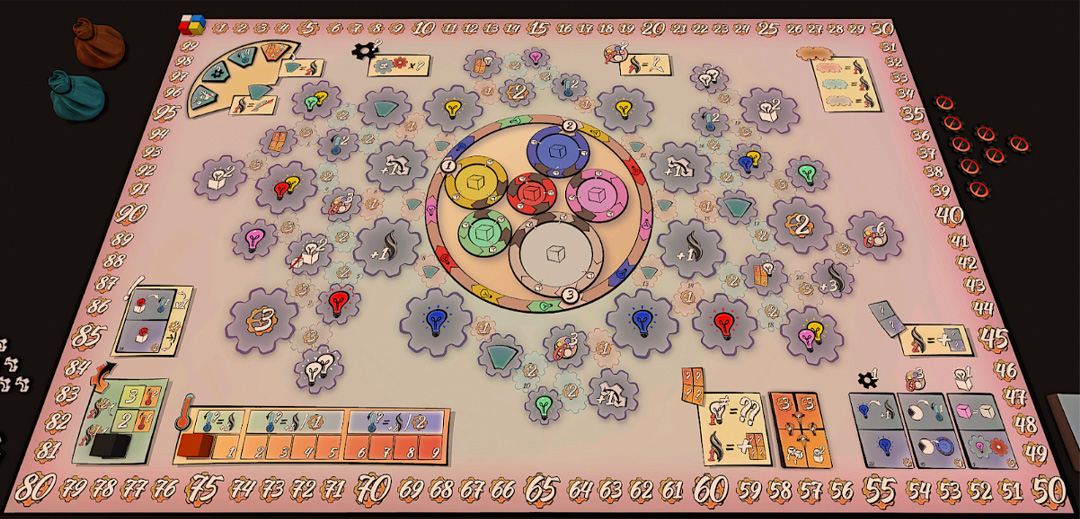

A common question whenever a designer is interviewed is, ‘Where do your game ideas come from?’. And the answer is always something similar to ‘they can come from anywhere when you least expect them’. Which is true, whatever you are doing, there’s always a chance an idea will pop up, a new theme, or a new mechanic for a game.
I usually have a hard time remembering what I was doing when I came up with the idea for a specific game, but I remember this one very clearly. It was while I was walking, following my usual looping route around a park, while pushing a stroller, trying to get my child, then less than a year old, to sleep for at least 40 minutes. It was in that state of sleep deprivation (for both of us), surrounded by trees, flowers, and the occasional fountain, when I thought it would be great to have a game using 2 connected cogs as an action selection mechanism. It would probably be about some kind of factory. If you were expecting me to say I was thinking about colorful tulip fields, I’m afraid that’s not where my mind was at that moment.
I kept refining the idea in my head during those walks, expanding it. It would not be a factory, it would be something else. I thought about a big cog in the middle of the main board, with many smaller cogs connected and expanding from it. I thought about steam and computers, and a grid of lightbulbs on your player board. Still, no windmills or tulips on my mind, as I was designing a game about being an AI inside a steampunk computer. I even had a name for it, which was either the best or the worst possible name for a board game: ‘Steam Perfected Mechanical Intelligence Apparatus of Countess Dorothy Harley-Willowby’.
Designing the Game
While the starting idea for the game was the 2 cogs mechanic, I quickly tried to find a matching theme for it to help me develop all the other mechanics. I thought about a steampunk computer, mixing cogs and steam with the look of early devices, which included lightbulbs (they were not technically lightbulbs, but close enough).
I do know how a computer works internally, so I started creating actions that matched that. It had a CPU to process information (moving in circles around several cogs) on the center of the board. There were spaces for smaller cogs that players could connect to the main cog, in order to write to memory, and activate later to read from memory. You could use the network action to send or receive data to and from other computers. It had programs and enhancements you could install on your player board. You could overclock the computer to make it work faster, but that would increase its heat, so at some point you would have to cool it down. And finally, a display made of lightbulbs of different colors to show the processed data.
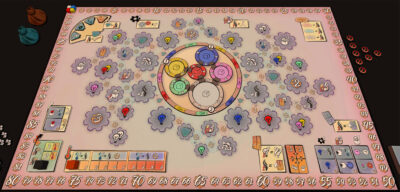
Obviously, none of this was perfectly balanced, it needed many playtests to come to its final version and working form, but the base was set since the beginning, and it worked reasonably well. The game had turns with way too many combos (unfortunately, that’s something a game can have too many of), because I originally wanted players to always activate the actions on both wheels, and I had to unwillingly limit that to only certain enhanced actions. But the most important part of the game, the thing I thought was the most original and that would be immediately interesting to any euro-gamer, were the 2 connected cogs, which worked really well.
It’s a system that has many consequences for every decision and creates great dilemmas each turn. As players add enhancements to their cogs, they are creating a unique set of powerful actions. It’s even more interesting by the fact that the wheels have different sizes, so with every revolution, the pairs of actions on each wheel align differently, creating a different set of possible actions. I also added rewards – every time a player makes a full revolution on their bigger wheel, the prize diminishes. In other words, the more players have already done it, the smaller the reward they get – that creates the first dilemma for players. They have to decide if they want to turn the wheels slowly, so they can activate all the enhanced actions they have added, or faster, so they can grab those better rewards before another player does.
But to make it even more interesting, the speed at which the wheels turn is shared between players. I can make them go faster and pay for it,, but then the next player will also be able to turn their wheels at that increased speed for free. But will they do it, considering that it means skipping a powerful action on their wheel?
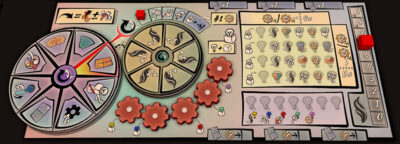
Of course, it wasn’t only the wheel that needed testing and polishing to make it work as intended, I had to work on all the other actions too, to make them all interesting, which was accomplished with the usual method of doing a lot of playtesting sessions. Once I was happy with it, I thought, ‘Who can be interested in a heavy game about steam and cogs?’.
Board & Dice
I signed this game with Board & Dice before Barcelona, so this was my first contact with them, and it couldn’t have gone better. An email, an online demonstration and 2 deliberation weeks later, a contract was signed, so I think they liked it.
The game had a few changes done, as they saw the potential for a lighter game (that is, light for B&D standards), as it was probably a bit heavier than Barcelona in its prototype form. Most importantly, the CPU mechanic was simplified, the read and write to memory actions were combined into a single action (making the player cogs smaller and the game shorter), and the process of adding lightbulbs to your display was made easier, as you now only needed to have the lightbulb in order to add it, while you also needed another resource of matching color to do it before.

The CPU became the central market, and instead of cogs connected to it, players would build windmills. The network action became foreign trade, and helpers replaced the programs. Instead of overclocking the computer to make it work faster, you would increase the water flow, and the rows of colors of the tulip fields perfectly matched the pattern players had to create on their display to get the most points. And, of course, a 2 word name would substitute my 10-long one.
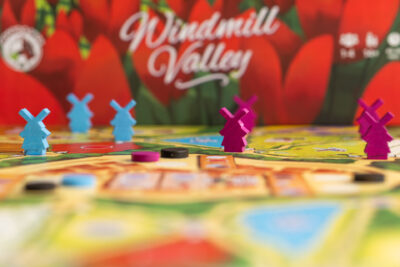
While there may be a time in the future for a complex game about a steampunk computer with an absurdly long name, now I can’t wait to see how players fill their patches with tulips. I’m always proud of the games, I do, and I think all of them have something special, but this wheel mechanism and how it interacts with the game is one I’m especially proud of, and I hope all players find it as interesting as I do.

Obviously, none of this was perfectly balanced, it needed many playtests to come to its final version and working form, but the base was set since the beginning, and it worked reasonably well. The game had turns with way too many combos (unfortunately, that’s something a game can have too many of), because I originally wanted players to always activate the actions on both wheels, and I had to unwillingly limit that to only certain enhanced actions. But the most important part of the game, the thing I thought was the most original and that would be immediately interesting to any euro-gamer, were the 2 connected cogs, which worked really well.
It’s a system that has many consequences for every decision and creates great dilemmas each turn. As players add enhancements to their cogs, they are creating a unique set of powerful actions. It’s even more interesting by the fact that the wheels have different sizes, so with every revolution, the pairs of actions on each wheel align differently, creating a different set of possible actions. I also added rewards – every time a player makes a full revolution on their bigger wheel, the prize diminishes. In other words, the more players have already done it, the smaller the reward they get – that creates the first dilemma for players. They have to decide if they want to turn the wheels slowly, so they can activate all the enhanced actions they have added, or faster, so they can grab those better rewards before another player does.
But to make it even more interesting, the speed at which the wheels turn is shared between players. I can make them go faster and pay for it,, but then the next player will also be able to turn their wheels at that increased speed for free. But will they do it, considering that it means skipping a powerful action on their wheel?

Of course, it wasn’t only the wheel that needed testing and polishing to make it work as intended, I had to work on all the other actions too, to make them all interesting, which was accomplished with the usual method of doing a lot of playtesting sessions. Once I was happy with it, I thought, ‘Who can be interested in a heavy game about steam and cogs?’.
Board & Dice
I signed this game with Board & Dice before Barcelona, so this was my first contact with them, and it couldn’t have gone better. An email, an online demonstration and 2 deliberation weeks later, a contract was signed, so I think they liked it.
The game had a few changes done, as they saw the potential for a lighter game (that is, light for B&D standards), as it was probably a bit heavier than Barcelona in its prototype form. Most importantly, the CPU mechanic was simplified, the read and write to memory actions were combined into a single action (making the player cogs smaller and the game shorter), and the process of adding lightbulbs to your display was made easier, as you now only needed to have the lightbulb in order to add it, while you also needed another resource of matching color to do it before.
The theme was also changed at this stage. They wanted a new theme to go with the changes, and they also probably wanted a name for the game that would not occupy half of the cover. The new theme, now finally with windmills and tulips, was suggested, and it seemed to match all the actions.

The CPU became the central market, and instead of cogs connected to it, players would build windmills. The network action became foreign trade, and helpers replaced the programs. Instead of overclocking the computer to make it work faster, you would increase the water flow, and the rows of colors of the tulip fields perfectly matched the pattern players had to create on their display to get the most points. And, of course, a 2 word name would substitute my 10-long one.

While there may be a time in the future for a complex game about a steampunk computer with an absurdly long name, now I can’t wait to see how players fill their patches with tulips. I’m always proud of the games, I do, and I think all of them have something special, but this wheel mechanism and how it interacts with the game is one I’m especially proud of, and I hope all players find it as interesting as I do.
